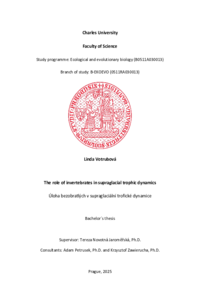The role of invertebrates in supraglacial trophic dynamics
Úloha bezobratlých v supraglaciální trofické dynamice
bachelor thesis (DEFENDED)

View/
Permanent link
http://hdl.handle.net/20.500.11956/199332Identifiers
Study Information System: 259033
Collections
- Kvalifikační práce [20861]
Author
Advisor
Consultant
Petrusek, Adam
Zawierucha, Krzysztof
Referee
Crosta, Arianna
Faculty / Institute
Faculty of Science
Discipline
Ecological and Evolutionary Biology
Department
Department of Ecology
Date of defense
30. 5. 2025
Publisher
Univerzita Karlova, Přírodovědecká fakultaLanguage
English
Grade
Excellent
Keywords (Czech)
ledovcový povrch, bezobratlí, ekologie, trophic dynamicsKeywords (English)
glacier surface, microinvertebrates, ecology, trofická dynamikaPovrch ledovců (supraglaciál) je biologicky aktivní a velmi produktivní ekosystém, který v rozličných habitatech obývá na chlad adaptovaná biota. Supraglaciální potravní sítě jsou krátké, ale i přesto mají více trofických úrovní, na jejichž vrcholu se často nachází bezobratlí konzumenti. V posledních letech dosáhlo mapování distribuce a diverzity těchto bezobratlých značného pokroku, nicméně výzkum a porozumění jejich ekologii je teprve v začátcích. Tato práce shrnuje současné poznatky o ledovcových bezobratlých z pohledu trofické ekologie, která umožňuje sledovat toky hmoty a energie, odhalit možné biotické interakce a zasadit je do kontextu převážně abioticky řízeného supraglaciálního ekosystému. Hlavním cílem této práce je odhalit mezery v současných znalostech a navrhnout možné směřování budoucího výzkumu. Shrnutím poznatků o supraglaciálních habitatech, jejich obyvatelích, dostupných zdrojích potravy a trofických interakcích bylo odhaleno, že poznatky jsou limitované na několik lokalit, habitatů a taxonů. Většina dostupných studií pochází z arktických a antarktických ledovců, přičemž z rovníkových ledovců jsou poznatky minimální. Velké množství studií se zabývá konzumenty v kryokonitových jamkách (želvuškami a vířníky), ale o jiných habitatech (např. sněhu v akumulační zóně, povrchových...
Glacier surfaces are highly biologically active and productive cryospheric ecosystems that comprise distinct habitats and cold-adapted biota. Local food webs are truncated, though multitrophic and usually topped with metazoan invertebrate consumers. In recent years, much progress has been made in mapping the diversity and distribution of these invertebrates, yet the research on their ecology is still in its early stages. This thesis reviews the current knowledge on these glacier-dwelling invertebrates through the lens of trophic ecology, as it allows us to follow the transfers of energy and matter, uncover possible biotic interactions and contextualise them in the dynamics of the primarily abiotically driven supraglacial ecosystem. The main aim of this thesis is to uncover the gaps in the knowledge and propose research priorities for the upcoming critical years. Summarising what we know about the supraglacial habitats and their invertebrate consumers, putative food sources and trophic interactions has revealed that current knowledge is limited to several geographic areas, habitats and taxa. While most of the research comes from the Arctic and Antarctic, rapidly changing areas like the equatorial glaciers remain less understood. Some supraglacial habitats and taxa remain heavily understudied...
